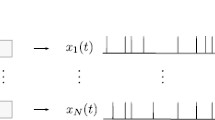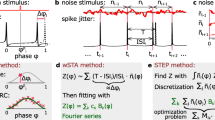Abstract
We show that populations of identical uncoupled neurons exhibit partial phase synchronization when stimulated with independent, random unidirectional current spikes with interspike time intervals drawn from a Poisson distribution. We characterize this partial synchronization using the phase distribution of the population, and consider analytical approximations and numerical simulations of phase-reduced models and the corresponding conductance-based models of typical Type I (Hindmarsh–Rose) and Type II (Hodgkin–Huxley) neurons, showing quantitatively how the extent of the partial phase synchronization depends on the magnitude and mean interspike frequency of the stimulus. Furthermore, we present several simple examples that disprove the notion that phase synchrony must be strongly related to spike synchrony. Instead, the importance of partial phase synchrony is shown to lie in its influence on the response of the population to stimulation, which we illustrate using first spike time histograms.








Similar content being viewed by others
References
Brown, E., Moehlis, J., & Holmes, P. (2004a). On the phase reduction and response dynamics of neural oscillator populations. Neural Computation, 16, 673–715.
Brown, E., Moehlis, J., Holmes, P., Clayton, E., Rajkowski, J., & Aston-Jones, G. (2004b). The influence of spike rate and stimulus duration on noradrenergic neurons. Journal of Computational Neuroscience, 17, 13–29.
Coffey, W. T., Kalmykov, Y. P., & Waldron, J. T. (2004). The Langevin Equation: With applications to stochaistic problems in physics, chemistry, and electrical engineering. Singapore: World Scientific.
Connor, J. A., Walter, D., & McKown, R. (1977). Neural repetitive firing: Modifications of the Hodgkin–Huxley axon suggested by experimental results from crustacean axons. Biophysical Journal, 18, 81–102.
Elble, R. J., & Koller, W. C. (1990). Tremor. Baltimore: Johns Hopkins University Press.
Ermentrout, G. B. (1996). Type I membranes, phase resetting curves, and synchrony. Neural Computation, 8, 979–1001.
Ermentrout, G. B. (2002). Simulating, analyzing, and animating dynamical systems: A guide to XPPAUT for researchers and students. Philadelphia: SIAM
Friedrich, R. W., & Stopfer, M. (2001). Recent dynamics in olfactory population coding. Current Opinion in Neurobiology, 11, 468–474.
Galán, R. F., Fourcaud-Trocmé N., Ermentrout, G. B., & Urban, N. N. (2006). Correlation-induced synchronization of oscillations in olfactory bulb neurons. Journal of Neuroscience, 26(14), 3646–3655.
Goldobin, D. S., & Pikovsky, A. (2005a). Synchronization and desynchronization of self-sustained oscillators by common noise. Physical Review E, 71, 045201.
Goldobin, D. S., & Pikovsky, A. (2005b). Synchronization of self-sustained oscillators by common white noise. Physica A, 351, 126–132.
Gray, C. M., König, P., Engel, A. K., & Singer, W. (1989). Oscillatory responses in cat visual cortex exhibit inter-columnar synchronization which reflects global stimulus properties. Nature, 338, 334–337.
Guckenheimer, J. (1975). Isochrons and phaseless sets. Journal of Mathematical Biology, 1, 259–273.
Gutkin, B. S., Ermentrout, G. B., & Reyes, A. D. (2005). Phase response curves give the responses of neurons to transient inputs. Journal of Neurophysiology, 94, 1623–1635.
Hodgkin, A. L., & Huxley, A. F. (1952). A quantitative description of membrane current and its application to conduction and excitation in nerve. Journal of Physiology, 117, 500–544.
Josić, K., Shea-Brown, E. T., & Moehlis, J. (2006). Isochron. Scholarpedia, 2509.
Klimesch, W. (1996). Memory processes, brain oscillations and EEG synchronization. International Journal of Psychophysiology, 24, 61–100.
Kopell, N. (2000). We got rhythm: Dynamical systems of the nervous system. Notices of the AMS, 47(1), 6–16.
Kuramoto, Y. (1984). Chemical oscillations, waves, and turbulence. Berlin: Springer
Mainen, Z. F., & Sejnowski, T. J. (1995). Reliability of spike timing in neocortical neurons. Science, 268, 1503–1506.
Nakao, H., Arai, K., Nagai, K., Tsubo, Y., & Kuramoto, Y. (2005). Synchrony of limit cycle oscillators induced by random external impulses. Physical Review E, 72, 026220.
Pare, D., Curro’Dossi, R., & Steriade, M. (1990). Neuronal basis of the Parkinsonian resting tremor: A hypothesis and its implications for treatment. Neuroscience, 35, 217–226.
Rinzel, J., & Ermentrout, G. B. (1998). Analysis of neural excitability and oscillations. In: C. Koch & I. Segev, (Eds.), Methods in neuronal modeling (pp. 251–291). MIT Press.
Rinzel, J., & Miller, R. N. (1980). Numerical calculations of stable and unstable periodic solutions to the Hodgkin–Huxley equations. Mathematical Biosciences, 49, 27–59.
Ritt, J. (2003). Evaluation of entrainment of a nonlinear neural oscillator to white noise. Physical Review E, 68(4), 041915 (Oct).
Rose, R., & Hindmarsh, J. (1989). The assembly of ionic currents in a thalamic neuron I. The three-dimensional model. Proceedings of the Royal Society of London. Series B, 237, 267–288.
Singer, W. (1993). Synchronization of cortical activity and its putative role in information processing and learning. Annual Review of Physiology, 55, 349–374.
Softky, W. R., & Koch, C. (1993). The highly irregular firing of cortical cells is inconsistent with temporal integration of random EPSPs. Journal of Neuroscience, 13(1), 334–350.
Stent, G. S. (1973). A physiological mechanism for Hebb’s postulate of learning. Proceedings of the National Academy of Sciences, 70, 997–1001.
Stevens, C. F., & Zador, A. M. (1998). Input synchrony and the irregular firing of cortical neurons. Nature Neuroscience, 1, 210–217.
Tass, P. A. (2000). Effective desynchronization by means of double-pulse phase resetting. Europhysics Letters, 53, 15–21.
Teramae, J., & Tanaka, D. (2004). Robustness of the noise-induced phase synchronization in a general class of limit cycle oscillators. Physical Review Letters, 93(20), 204103.
Traub, R. D., Miles, R., & Wong, R. K. S. (1989). Model of the origin of rhythmic population oscillations in the hippocampal slice. Science, 243, 1319–1325.
Usrey, W. M., & Reid, R. C. (1999). Synchronous activity in the visual system. Annual Review of Physiology, 61, 435–456.
Winfree, A. (1974). Patterns of phase compromise in biological cycles. Journal of Mathematical Biology, 1, 73–95.
Winfree, A. (2001). The geometry of biological time (2nd ed.). New York: Springer.
Acknowledgements
This work was supported by the National Science Foundation grant NSF-0547606 and a University of California Council on Research and Instructional Resources Faculty Research Grant. P.D. acknowledges an National Science Foundation IGERT Fellowship in Computational Science and Engineering. G.B. is partially supported by NIH Grant R01 GM078993. J.M. acknowledges an Alfred P. Sloan Research Fellowship in Mathematics. We thank the anonymous referees for helpful comments.
Author information
Authors and Affiliations
Corresponding author
Additional information
Action Editor: G. Bard Ermentrout
Rights and permissions
About this article
Cite this article
Danzl, P., Hansen, R., Bonnet, G. et al. Partial phase synchronization of neural populations due to random Poisson inputs. J Comput Neurosci 25, 141–157 (2008). https://doi.org/10.1007/s10827-007-0069-z
Received:
Revised:
Accepted:
Published:
Issue Date:
DOI: https://doi.org/10.1007/s10827-007-0069-z




